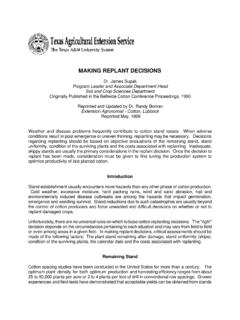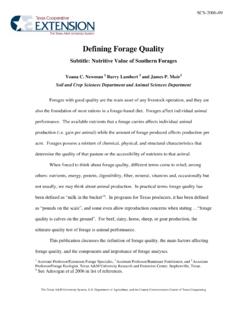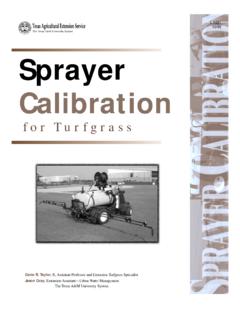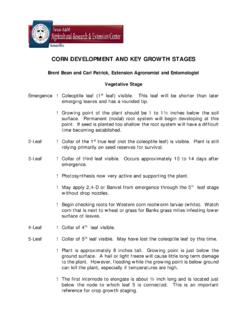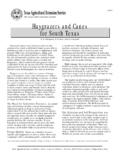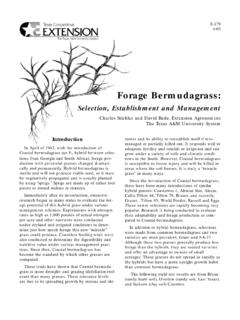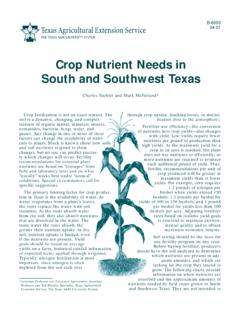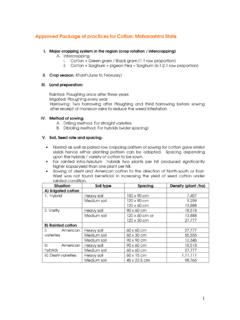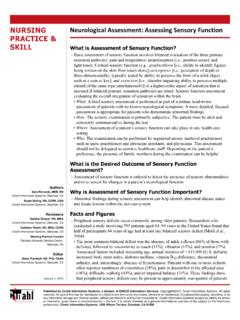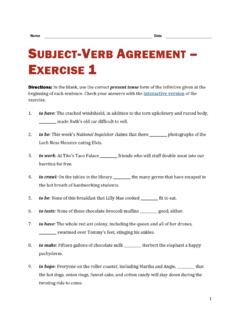Transcription of Weed Management in Texas Cotton - Texas A&M …
1 SCS-2013-09. weed Management in Texas Cotton Gaylon D. Morgan, Professor and State Extension Cotton Agronomist Paul A. Baumann, Professor and State Extension weed Specialist Peter A. Dotray, Professor and Extension weed Specialist Texas A&M AgriLife Extension Service Tables for Herbicide Application Timings 1. Preplant Burndown 2. Preplant Incorporated 3. Preemergence 4. Postemergence 5. Post-Directed or Hooded 6. Wick or Wiper Applications 7. Herbicides, Formulations, Group Numbers, and Mechanism-of-Action The suggestions contained herein are based primarily on herbicide labels and research conducted by Texas A&M AgriLife Extension Service and Texas A&M AgriLife Research. The use of product names is not intended as an endorsement of the product or of a specific manufacturer, nor is there any implication that other formulations containing the same active chemical are not equally effective.
2 Product names are included solely to aid readers in locating and identifying the herbicides suggested. Overview of weed Management in Cotton weed control in Cotton can be accomplished through the integrated use of cultural, mechanical and chemical means. Used judiciously, these individual methods or a combination of them can effectively manage weeds without causing economic loss or adverse environmental effects. Deciding which practices to employ will depend largely on the infestation level and the weed (s) being controlled. Also, the planting date, herbicide tolerance traits, presence of herbicide resistant weeds, and other crop Management practices will play a major role in determining the most economical and effective Management strategy. Considerations for cultural and mechanical weed control should include: Remove light or spotty infestations of weeds by spot cultivation to prevent spreading weed seed, rhizomes or roots.
3 This is of particular importance with perennial weeds because of the way they propagate (by seed and root tissue). Be careful when plowing perennial weeds so that you don't spread plant parts to other areas of the field. Use weed -free planting seed to protect against weed infestations in the row and the introduction of new weed species or herbicide resistant weeds. Use mechanical tillage to remove initial weed flushes before planting, thereby eliminating or at least reducing the potential for continued infestation. Consider the economics of using mechanical cultivation alone for weed control in the crop, especially where only light infestations of annual weeds are present. Practice rotation to crops which physically out-compete certain weeds, resulting in their gradual decline. Thoroughly clean harvesting equipment before moving from one field to the next, or require it of the custom harvesters before they enter your fields.
4 Consider using herbicides with different mechanisms of action (site of action) during the growing season to help prevent the development of herbicide resistant weed populations (Table 7). Early-season weed Management , including preplant burndown (PPB), preplant incorporated (PPI), and preemergence (PRE) herbicides are critical part(s) to each weed Management program, especially in Cotton . Due to Cotton 's perennial nature, it devotes much of its early-season energy to its root system and less energy to shoot growth. As a result of the slow early-season shoot growth and wide row spacing, Cotton is not very competitive with weeds and weed control is essential to preserving Cotton yields. Also, the use of residual herbicides provides additional flexibility when employing postemergence application timings. Last, applications PPB, PPI, and PREs provide a good opportunity to rotate herbicides, which will assist in managing and preventing the development of herbicide resistant weeds.
5 Strategies for managing Herbicide Resistant weeds. 1. Employ integrated weed Management strategies. Use herbicides only when necessary, and combine their use with mechanical, cultural, or biological methods. 2. Rotate or mix herbicides with different Mechanisms-of-Action. See Table 7 for listing of herbicide, Group Number, and its Mechanism-of-Action. 3. If possible, rotate crops where herbicide rotations are feasible. 4. Scout fields regularly to determine if resistant weeds populations may be present and control the weed escapes before they produce seed. 5. Make sure harvest equipment is cleaned, if being transported from regions with herbicide resistant weeds. 6. Clean tillage and harvest equipment to prevent the spread of resistant species to other regions. Information given herein is for educational purposes only. Reference to commercial products or trade names is made with the understanding that no discrimination is intended and no endorsement by Texas A&M AgriLife Extension Service is implied.
6 This publication is no substitute for the herbicide product labels. It is intended to serve only as a guide for controlling weeds in Cotton . Labeled rates and restrictions change constantly; therefore, consult the product label before use. Table 1. PrePlant Burndown weed Management Options Product, Rate/A, Weeds Herbicide controlled name Time to apply Remarks Henbit, seedling Caparol 4L Fall or winter Use in Gulf Coast and Blacklands only. For best dock pt either results, apply before weed emergence. If henbit has emerged but is less than 4 6 in tall, (prometryn) preemergence or add a surfactant or emulsifiable oil. This is for winter weed control only. Additional postemergence to herbicides will be needed for spring and summer weed control. small winter weeds. Annual and Clarity Fall or winter when Do not make applications in regions with less than 25 inches of average annual perennial broadleaf 8 fl oz weeds are 2-4 lf precipitation.
7 Plant Cotton only after a minimum of 1 inch of rainfall or overhead irrigation weeds (diglycolamine) stage and rosettes and 21 days after application. are less than 2. inches across Horseweed, henbit, Envoke Early preplant. Currently labeled in Texas east of I-35. Apply alone or in tank mixture for residual control shepherd's purse oz or suppression with a minimum of 90 days before planting Cotton . (trifloxysulfuron) Refer to label for tank mix options. Annual broadleaf Firstshot Postemergence to Allow 30 days after application before planting Cotton . Allow 37 days on sands, loamy weeds oz/a weeds before sands or sandy loams before planting. Allow 37 days on high pH soils (> ) before (thifensulfuron- planting. planting. Maybe tank mixed with other herbicides to control additional weeds. methyl (25%). plus tribenuron (25%). Henbit, sunflower Glyphosate Postemergence to Allow at least 2 weeks after application before tillage.)
8 If glyphosate resistant weeds are Refer to label products weeds before present, add a tank mix partner to control emerged and provide residual weed control. 1 pt 1 qt planting. (glyphosate +. surfactant). Selected broadleaf Goal 2XL Preemergence or Some residual weed control may be expected. Apply to weed seedlings not exceeding weeds 1 2 pt postemergence to four true leaves. Fallow beds should be worked thoroughly to a minimum depth of at Refer to label (oxyfluorfen) weeds. least in before planting. Do not apply within 7 days before planting. Failure to meet these requirements may result in stand reduction and/or vigor reduction. Postemergence applications require 20 gal/a of water by ground or 10 gal/a of water aerially. Emerged annual Gramoxone Before planting, by Before planting, prepare land to permit maximum weed and grass emergence broadleaf weeds Inteon ground application before treatment.
9 Seeding should be done with minimum soil disturbance. Weeds and and grasses and pt to weeds and grasses emerging after application will not be controlled. This is a restricted-use topkill suppression (paraquat grasses 1 6 in tall. herbicide. Apply in a minimum of 10 gal water/a by ground plus 1 qt nonionic surfactant of perennials dichloride) per 100 gal spray solution or 1 gal crop oil concentrate per 100 gal spray solution. At lower spray volumes a drift control or spray deposition additive should be used. Check label for tank mix options. Numerous annual LeadOff Postemergence at Add nonionic surfactant to spray mixture. Multiple tank mix partners are labeled. Consult broadleaf weeds oz least 30 days label for additional information. Refer to label (thifensulfuron- before planting. methyl ( ). plus rimsulfuron ( ). Refer to label for list Liberty 280 SL Application may be Refer to label for specific rates, weeds controlled and tank mix options.)
10 Of weeds controlled 22 43 oz made in fallow Apply in 15 gal/a of water minimum by ground or a minimum of 10 gal aerially. or suppressed (glufosinate- fields, postharvest, Do not apply if rain is expected within 4 hours after application ammonium) before planting or Season total application may not exceed 72 or 87 oz/a depending on initial application emergence of rate. Warm temperatures, high humidity, and bright sunlight improve performance. Cotton . Sequential applications should be made at least 10-14 days apart. Many annual Roundup Before emergence Apply when weeds are vigorously growing and are 6 in or less tall. Consult label for broadleaf and grass WeatherMax of Cotton . specific rate and weed heights. Do not apply by ground when winds are gusty or more weeds. 11 32 oz than 10 mph. For aerial applications, do not apply during inversion conditions when Refer to label for (glyphosate) winds are gusty or under other conditions that will allow drift.
